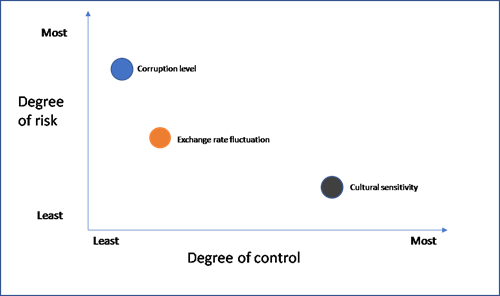
Dealing with risk when exporting overseas
Marketing risk identification and management in today’s global environment
Businesses looking to unlock foreign markets need to identify the risks, understand the potential impact of those risks and have a clear strategy to manage them. That all sounds good, but where do you start?
Analysing the risks
Let’s look at the types of risks associated with marketing internationally. These can range across a variety of areas including; cultural, financial, political, legal, management, and infrastructure.
Cultural:
Cultural risks usually stem from two areas; a brand’s country of origin, which may make it harder to trade in other markets or from a brand’s personal image. For example, a lack of understanding about how to operate in local markets, and poorly translated marketing assets will harm your business’ marketing opportunities abroad. This is also an important consideration for business meetings; marketers’ need an awareness of cultural differences which include the interpretation of body language, gestures, symbols and other common business practices.
Financial:
Price setting can be a real challenge – particularly in lower cost markets where local competition has the ability to match or beat your pricing. Marketers must also consider the impact that the value of Sterling has on the price of its products or services abroad. Currency exposure can be harmful to businesses if not planned and prepared for, and many businesses will want to consider contingency planning ahead of Brexit.

Political risk:
Politics and policy can be big risks. If a country’s growth policy is based on local investment, employment and buying products and services which are from that country of origin, this can put an exporting business at a significant disadvantage. When seeking new markets, marketers should research that country’s economic stability, trading policies and corruption levels, as these may all have a direct or indirect impact on a businesses’ ability to sell products and services.
Legal:
Marketers must ensure they have a comprehensive understanding of a country’s laws that may impact your ability to sell products or services, as failing to do so could delay exports getting into the market. Other risks to consider are whether or not there are costs to ensure compliance with local laws, as this may impact the cost to sell a product or service. On the flip side, having a robust knowledge of legal implications in different markets will mean that your business can identify markets which are both commercially suitable and where international trading laws are less restrictive.

Management:
Exploring new markets requires highly-skilled and expert teams that can competently lead a business to new exporting opportunities and successfully unlock markets. From a marketing perspective, it is vital that teams have professional training and understand the importance of understanding a prospect market.
Infrastructure:
Finally, marketers need to consider whether there are infrastructure barriers that may stop them from successfully exporting a product or service to a new country. For example, if you are looking to unlock new markets for an electrical based product, ensure that your target countries have infrastructure that can support this.
Risk impact and control
Once you have reviewed the above risks, the next step is to assess each one in terms of their degree of influence and understand to what extent they can be controlled and anticipated. Controlling risk allows businesses’ the opportunity to plan, and even, if possible to use as an advantage.
If we take political, economic and cultural risks from the above list we can map them on a scale. Depending on where each risk sits on the scale is a good indication of how they need to be managed – see the diagram below.

Tools and modelling
So, what are some of the ways to identify risks in international markets? There are many tools and resources we can use to assess risk. Two interesting approaches are the market maturity assessment and the Hofstede tool.

1) Market maturity assessment
If your product or service is price or economy sensitive, marketers must consider the economic classification of countries such as advanced economies in developing and less developed countries. There are several reports which can be used to accurately identify which countries match this description for your market sector. Such reports include assessment of political stability, GNI per capita views or the wealth pyramid views:
• https://data.worldbank.org/indicator/NY.GNP.PCAP.CN?locations=BH-EE
• https://www.weforum.org/agenda/2016/01/a-world-of-simmering-unrest/
• https://www.credit-suisse.com/corporate/en/articles/news-and-expertise/global-wealth-report-2017-201711.html
2) Cultural modelling
Cultural models such as the Hostede cultural model offer useful cultural insights on a range of different criteria for most countries across the world. Hofstede over the decades has identified approximately six parameters including: individualistic, masculine and feminine, uncertainty, power/distance, time perspective and indulgence. The skill is interpreting and applying that insight to your area of business so that you can take the relevant actions. As a first look one can use the tool on the website to see differences between a home country and the destination market can be seen here.
Risk management
Risks can be managed across four different areas; avoidance - where certain regions or countries have risks that are too great; mitigation - if a business aims to reduce the likelihood and the consequence of the risk; transference - where the risk is passed on to, or stored in another party; and absorption - where the potential risk is accepted in the hope that the consequences can be coped with, if necessary.
Businesses can manage risk by categorising them accordingly e.g. bypass, absorption, reduction, transfer or BART (see the below a risk management table with examples). For example, cultural risks can be mitigated through local knowledge captured either through employing a local partner, reseller, or employing people from the region in the company. Other ways to minimise risk can mean using online/digital marketing activities to test marketing and/or messages before fully launching the activity.
The below table summarises how risks can be ranked, categorised and managed:

Working through these steps; identification, categorising and management is just the first stage in the process. This should be followed-up with implementation and monitoring tactics on an ongoing basis to ensure longer term success in a new market.
For more information on how you can export, drive your marketing internationally or just understand your options in the face of Brexit, please see the International Marketing for SMEs training course.